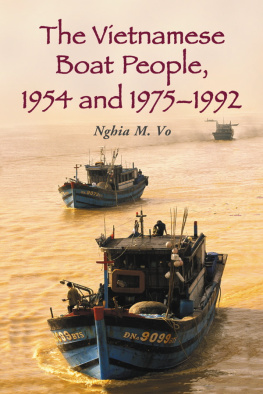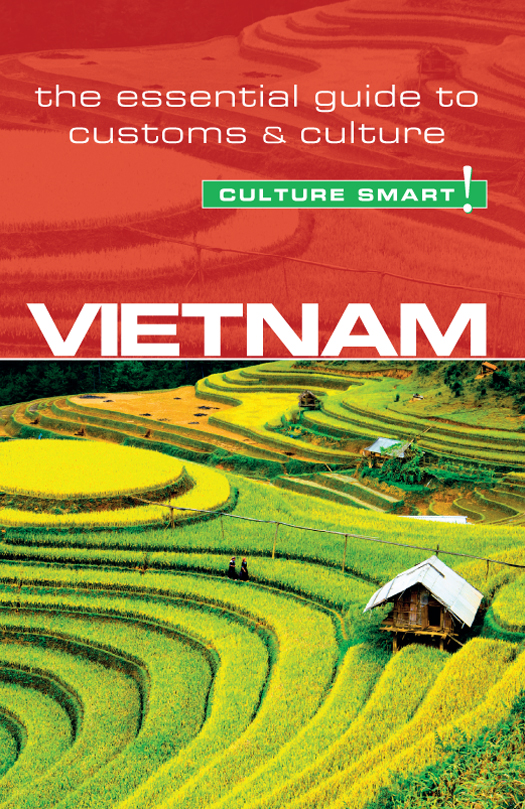Copyright 2016 Kuperard
Revised and updated edition 2016
All rights reserved. No part of this publication may be reprinted or reproduced, stored in a retrieval system, or transmitted in any form or by any means without prior permission in writing from the publishers.
Culture Smart! is a registered trademark of Bravo Ltd.
ISBN 978 1 85733 834 8
This book is also available as an e-book: eISBN 978 1 85733 835 5
British Library Cataloguing in Publication Data
A CIP catalogue entry for this book is available from the British Library
First published in Great Britain
by Kuperard, an imprint of Bravo Ltd
59 Hutton Grove, London N12 8DS
Tel: +44 (0) 20 8446 2440 Fax: +44 (0) 20 8446 2441
www.culturesmart.co.uk
Inquiries:
Series Editor Geoffrey Chesler
Design Bobby Birchall
Cover image: Terraced rice fields 1,000 meters above sea level in the steep valleys of Mu Cang Chai, Yen Bai Province, northeast Vietnam. Shutterstock.
Photograph on by courtesy of Le Thi Thu Hang.
Image on Shutterstock.
Images on the following pages reproduced under Creative Commons Attribution-Share Alike 4.0 International license: Tango7174.
Reproduced under Creative Commons Attribution-Share Alike 3.0 Unported license: Ng Trung.
Under Creative Commons Attribution-Share Alike 2.5 Generic license: Mike Williams.
Under Creative Commons Attribution-Share Alike 2.0 Generic license: A J Oswald.
Under Creative Commons CC0 1.0 Universal Public Domain Dedication: cocoparisienne.
eBook ISBN: 978-1-85733-835-5
v3.1
About the Author
GEOFFREY MURRAY has worked in Asia for more than forty years as a journalist, author, and teacher, including long stays in China, India, Japan, and Singapore. So far, he has published fifteen books on a wide range of business and socioeconomic issues, mostly about China, but also including Vietnam: Dawn of a New Market and Simple Guide to the Customs and Etiquette of Vietnam, both in 1997. He has closely followed developments in Vietnam ever since he served as a news agency war correspondent with the Australian army in the mid-1960s, winning the Australian governments Vietnam Logistic and Support Medal. He is officially listed as a Vietnam War veteran by the Australian government.
The Culture Smart! series is continuing to expand.
For further information and latest titles visit
www.culturesmart.co.uk
The publishers would like to thank CultureSmart!Consulting for its help in researching and developing the concept for this series.
CultureSmart!Consulting creates tailor-made seminars and consultancy programs to meet a wide range of corporate, public-sector, and individual needs. Whether delivering courses on multicultural team building in the USA, preparing Chinese engineers for a posting in Europe, training call-center staff in India, or raising the awareness of police forces to the needs of diverse ethnic communities, it provides essential, practical, and powerful skills worldwide to an increasingly international workforce.
For details, visit www.culturesmartconsulting.com
CultureSmart!Consulting and CultureSmart! guides have both contributed to and featured regularly in the weekly travel program Fast Track on BBC World TV.
contents
Map of Vietnam
introduction
In the second half of the twentieth century, Vietnam was in the headlines for all the wrong reasons. War raged. It was hard to know if it would ever end, harder still to understand fully the rights and wrongs of the various protagonists. First, the French tried to stem the tide of Vietnamese nationalism; then the United States pitted itself against what it thought was a puny enemy, but which turned out to be tough, resilient, and ultimately victorious. The Americans might have pondered the fact that the Vietnamese had struggled, eventually successfully, for over a thousand years to escape the clutches of their powerful neighbor, China. Patience in adversity sums up the Vietnamese character.
Since the country was reunified in 1975, the Vietnamese have undergone many hardships. The immediate postwar years were extremely harsh for many people in South Vietnam. Some fled into exile; others underwent rehabilitation to make them fit to live in a Communist state. To this were added economic hardships and even starvation.
Today, however, life has improved significantly. The decision to abandon one of the main tenets of Marxism, the centrally planned economy, in favor of a socialist market economy was a bold step, as was the decision to throw open the doors and invite the world, including former foes, to invest in the new Vietnam. As a result, the economy is one of the worlds fastest growing.
Visitors will find a confident, independent people, nursing few if any grudges about the sufferings caused by the war. They are open and friendly, with a sense of humor and irony, and frankly curious about the outside world. Kind and generally helpful toward strangers, they are industrious, determined to improve their living standards, relatively honest, but always ready to seize any advantage that might come their way.
Culture Smart! Vietnam is aimed at the visitor who would like to learn a little more about the history, culture, traditions, sensibilities, and modern way of life of the Vietnamese. It explains deep-seated attitudes and describes some of the social, economic, and cultural changes now under way. It dispels common Western misconceptions and gives practical advice on what to expect and how to behave in unfamiliar situations. Whether you are visiting on business or for pleasure, we hope it will enable you to discover for yourself the warmth and vast potential of this fascinating country and its delightful people.
Key Facts
| Official Name | Socialist Republic of Viet Nam | In Vietnamese, Cong Hoa Xa Hoi Chu Nghia Viet Nam |
| Capital City | Hanoi |
| Main Cities | Ho Chi Minh City (formerly Saigon), Can Tho, Da Nang, Hue, Vinh, Haiphong | Main ports: Ho Chi Minh City (Saigon), Cam Ranh Bay, Da Nang, Haiphong |
| Area | 127,243 sq. miles (329,560 sq. km) |
| Terrain | Deltas in south and north; central highlands; hilly or mountainous, in far north and northwest | Major waterways: Red River (north) and Mekong River (south) |
| Climate | Tropical in south; monsoonal in north | Occasional typhoons |
| Population | 90,493,352 (April 2014) | Pop. growth rate: 1.06% est. |
| Ethnic Makeup | Vietnamese 8590%; remainder Chinese, Hmong, Thai, Khmer, Cham, and mountain tribes | Minorities other than Chinese live mainly in border regions. |
| Life Expectancy |

















